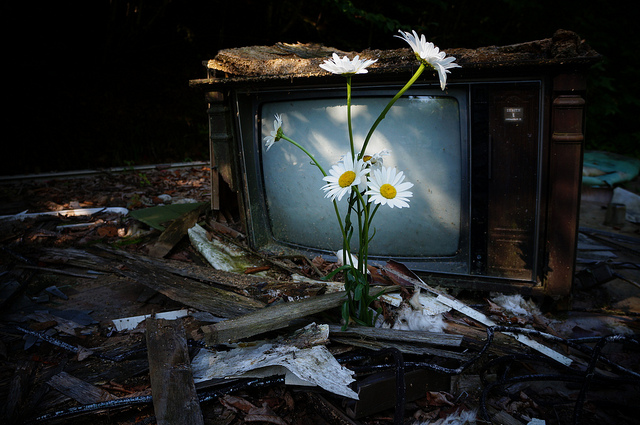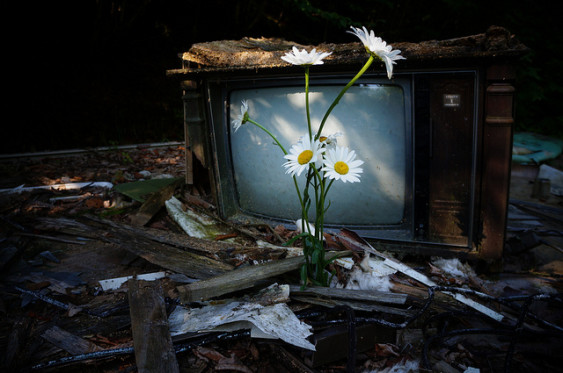A year ago today, in the small hours of the morning, a parked oil train slipped its brakes, rolled downhill, and derailed in a small town in Quebec. When the tank cars breached, they caught fire and erupted into a towering fireball that leveled several blocks of town and incinerated 47 people almost instantly.
That horrific disaster ushered in a new era of fear about crude oil-by-rail shipments.
Two weeks earlier Sightline had published the first regional inventory anywhere of oil-by-rail projects. We pointed out that Oregon and Washington are home to nearly a dozen active or proposed oil train depots that in aggregate would move about as much crude as the Keystone XL Pipeline—and far more than the region’s oil refining capacity. We released the report widely, and the response we got back sounded a lot like crickets chirping.
But after the explosion in Quebec, our phones started ringing off the hook.
As a result of growing interest in the subject, we devoted ourselves to researching and explaining the issue. Here are some of the most important things we’ve learned about oil-by-rail since Lac-Mégantic:
- Crude oil haulage is the single biggest growth sector for US railroads, and oil-by-rail shipments are up at least 57 times above pre-2009 levels.
- There is no consensus about why the light shale oil from the Bakken formation (the source of the oil in the Quebec train, and the source of the oil in Northwest trains now) is so risky. Some suggest it’s concentrations of hydrogen sulfide, while others point to volatile compounds and an exceptionally low flash point. Curiously, the American Petroleum Institute argues that all oil is as dangerous as Bakken oil.
- Federal safety inspectors have known for years—for decades, really—that the most common oil tank cars are riddled with design flaws that render oil transport inherently risky. Yet despite overwhelming evidence, both the oil and rail industries lobby policymakers to stall or defang new safety regulations. In fact, the industry has plainly told the feds they they have no plans to remove the older unsafe tank cars from service any time soon. Worse yet, even the newer model tank cars for carrying oil have design flaws, cannot safely be intermingled with older cars, and in at least one case actually derailed and caught fire.
- Railroads are so under-insured against the risk of catastrophic accident that they are, for all intents and purposes, uninsured against the costs of a Lac-Mégantic-style explosion in a densely populated area. If something awful happened, taxpayers would be on the hook. Regardless, the dominant railroad in the Northwest, BNSF, continues to route loaded oil trains through the heart of cities including, for example, within just a few feet of a major league baseball stadium during the ninth inning.
- Despite the fact that the Northwest region sees about nine freight train derailments each month, BNSF maintains a rocky relationship with its workers. The railroad opposed union-supported state legislation to require two-man crews on trains, legislation that responded in part to the fact that the Lac-Mégantic train was operated by a solo engineer, just as it opposed even basic information disclosure about oil shipping. Workers for the railroad complain that BNSF sometimes prioritizes speed over thorough safety procedures and that it requires crews operating trains to stay awake for as long as 24 hours.
- The “Bakken boom,” as the big shale oil extraction bonanza in North Dakota is commonly called, could well turn out to be a classic bubble. If federal regulators issue an emergency order to stop shipping oil in older-model unsafe tank cars—already thoroughly justified and well within their authority—Bakken oil extraction would, by necessity, decline dramatically because there would be no way to move it to market.
The Lac-Mégantic disaster was not a one-time event. In the months that followed, oil trains blew up in Alabama, New Brunswick, North Dakota, and Virginia. Thankfully, no one else was killed.
Yet the risks remain very real for communities across North America, and particularly in the Northwest, where the oil industry has its sights set on a massive increase in oil trains. Most controversial are three proposed terminals in Grays Harbor and a titanic oil transfer facility planned for the Columbia River at Vancouver, Washington.











Sandy Wood
Which community will be the “sacrificial lamb” before the Federal Government steps in to control the situation?
We all talk about the danger, note derailments and fires, yet cannot make the decision to halt the transfer of oil on the rail. Volatile cargo, rails damaged by the heavy weight of both oil and coal trains, unsafe rail cars, and railroad employees tired and unable to do safety checks, all add up to when? not if? a disaster will happen.
Dan McFarling
I don’t find anything to disagree with in this article. I strongly agree that railroads need to be more cooperative and place much more emphasis on safety.
But what really concern me is the failure of the media and officials to recognize that government promotion and subsidy of highway and aviation transport has shifted much of our transport away from relatively safe, energy efficient, labor efficient, cost effective and environmentally sound rail and onto less safe, more expensive, labor and fuel intensive forms of transport. AND because government policies at all levels have promoted and subsidized the proliferation of highway and aviation infrastructure, railroads have had little choice but to downsize and de-emphasize safety.
Generally speaking, rail is the only mode that is expected to use private funds to acquire, develop, maintain, police and signalize their right-of-way. AND they pay taxes on their ROW AND the improvements thereon. This forces railroads to minimize their infrastructure and minimize safety measures in order to compete with highway and aviation.
Highways and aviation rely in part or in whole on TAX-FREE ROW AND improvements that is acquired, developed, maintained, policed and signalized by taxpayers. Those tax dollars the railroads must pay? They are used in part to help cover the costs on highways and aviation.
WE need all transportation modes. Each mode has tasks for which they are better suited. But we need to correct the underlying problems that forces downsizing of rail infrastructure, capacity AND SAFETY while dumping billions into highways and aviation.
Dan McFarling
Sorry for the sloppy grammar- I usually try to correct that before posting …
Ron Schalow
BAKKEN CRUDE IS EXPLOSIVE, BUT IT DOESN’T NEED TO BE
FACT: Bakken crude oil from North Dakota does not have to be explosive. Oil producers have been removing (stripping/stabilizing) the natural gas liquids (NGL’s), and explosive gases, from crude oil for nearly a century, to make the crude safer for transport. It will still burn, but it will NOT EXPLODE!
WHY DON’T BAKKEN PRODUCERS REMOVE THE NGL’s? They don’t want to lose the income. NGL’s can be as much as 30% of a barrel. Since the producers weren’t smart enough, or too cheap, to buy the equipment and build infrastructure needed to sell off the NGL’s separately…ethane, butane, propane, methane, heptane, isobutane, pentane. h2s, and so on, many/most have just poured all/most of the NGL’s into the tanker car for the revenue.
NORTH DAKOTA OFFICIALS & REGULATORS HAVE LOOKED THE OTHER WAY: Republicans hold all statewide offices, and have a Supermajority in the House and Senate. They have a cozy relationship with the Bakken producers. You can speculate as to why. BOTTOM LINE: They’ve chosen the producers over the safety of the public.
OIL COMPANIES WON’T FIX THIS ISSUE ON THEIR OWN: You know why. It rhymes with MONEY.
THE FOLLOWING PEOPLE HAVE THE POWER TO MAKE THE EXPLOSIONS STOP…
The North Dakota Industrial Commission ndicinfo@nd.gov
(Governor, Ag Commissioner, & Attorney General)
Governor Jack Dalrymple
Chief of Staff Ron Rauschenberger rrausche@nd.gov
Senior Policy Advisors
Kayla Effertz kmeffertz@nd.gov
Jody Link jlink@nd.gov
Tami Ternes tlternes@nd.gov
Andrea Travnicek atravnicek@nd.gov
Jerod Tufte jetufte@nd.gov
Jeff Zent jlzent@nd.gov
Ag Commissoner Doug Goehring
Deputy Ag Commissioner Tom Bodine tbodine@nd.gov
Assistant to the Commissioner Jody Reinke jodyreinke@nd.gov
ndda@nd.gov @NDagriculture
Attorney General Wayne Stenehjem wstenehjem@nd.gov @WStenehjem
ndag@nd.gov
The North Dakota Public Service Commission ndpsc@nd.gov@NDPSC
Commissioner Julie Fedorchak jfedorchak@nd.gov @fedorchak4PSC
Commissioner Randy Christmann rchristmann@nd.gov @Christmann_R
Commissioner Brian Kalk bkalk@nd.gov brian@briankalk.com @briankalk
The North Dakota Department of Mineral Resources
Oil & Gas Division oilandgasinfo@nd.gov
Director Lynn Helms lhelms@nd.gov
Assistant Director Oil and Gas Division Bruce E. Hicks bhicks@nd.gov
Spokesperson Alison Ritter amritter@nd.gov
The North Dakota Pipeline Authority
Director Justin Kringstad jjkringstad@ndpipelines.com
(Lobbyists) The North Dakota Petroleum Council ndpc@ndoil.org
President Ron Ness ronness@ndoil.org
Vice President Kari Cutting kcutting@ndoil.org
Spokesperson Tessa Sandstrom tsandstrom@ndoil.org
Steve Ongerth
May we copy this article on our site?
Also, be sure to reach out to railroad workers who’ve also been victimized by the rail carriers: http://ecology.iww.org/node/538 – Rail Workers Raise Doubts About Safety Culture As Oil Trains Roll On
Eric de Place
Yes, you may. Please see the terms of Sightline’s free use policy.